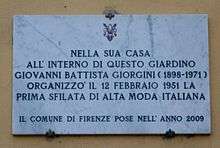Giovanni Battista Giorgini

Giovanni Battista Giorgini (Forte dei Marmi, 25 August 1898 - Florence, 2 January 1971), was an Italian entrepreneur and member of the Giorgini family.
Early life and family
Giovanni Battista Giorgini, the Giorgini family descends from a noble family from Lucca. His great-grandfather Charles was a member of the Kingdom of Italy and was the brother of Senator Giovanni Battista Giorgini and brother-in-law of Vittoria Manzoni, the eighth daughter of Alessandro Manzoni. His father, Vittorio Giorgini (1860-1919) helped his brother Alessandro in the family business dedicated to the marble trade, but he had an artistic spirit. The mother, Florence Rochat (1860-1942) was Waldensian and originally from Francophone Switzerland. The boy grew up in a cultured and cosmopolitan environment and undertook classical studies at the University of Pisa.
At the age of 17, he followed his family footsteps and enrolled as a volunteer in infantry to participate in the First World War. Impressed by the horrors of the war promoted the Christian Youth Association, equivalent to the evangelical organization "Young Men's Christian Association" (YMCA).
In 1921 he married Zaira Augusta Nanni with whom he had three children: Graziella, Vittorio and Matilde.
Career
The following year he moved to Florence where he decided to start his own business by opening the "GB Giorgini & Co. Import-export" in via Calzaioli 9. He actively promotes Tuscan art, antiques and crafts, and in 1924 he will make his first commercial trip to the United States. This trip was particularly painful because at the time Italian exporters were not well seen overseas. He decided to develop contacts with the "Italian House of Columbia University", "Italy America Society" and the YMCA and at the same time he selected a high quality Italian craftsmanship.
The crack of 1929 gave a heavy blow to his work and forced him to close his New York office. The years that followed were very unstable until the end of the Second World War , when the allies entrusted him with the management of the "Allied Forces Gift Shop" of Florence, a pole in charge of selling products to Anglo-American troops. In those years he quickly resumed contact with all the Italian artisans with whom he had worked before the war, and of course with the American buyers.
Skillful businessman immediately sees the potential of Italian fashion, then almost unknown in the world. Everything took place in Paris, where the few non-French designers opened their Ateliers ( Cristobal Balenciaga , Elsa Schiaparelli , etc.). Giovanni Battista Giorgini took the initiative to organize the "First Italian High Fashion Show" at his private residence in Florence at Villa Torrigiani. The parade was held February 12, 1951 in the presence of six major American buyers, who, as he himself said in various interviews, went to Florence as a simple courtesy visit.[1] It was: Gertrude Ziminsky for B. Altman and Company of New York, John Nixon for Henry Morgan of Montreal, Ethel Francau, Jessica Daves and Julia Trissel for Bergdorf Goodman of New York, Stella Hanania for I. Magnin of San Francisco. Giorgini had planned to present 18 models of 10 Italian fashion houses. Among those who presented their models there were: the atelier Carosa (of the princess Giovanna Caracciolo), Alberto Fabiani , the atelier Simonetta (of the Duchess Simonetta Colonna Visconti ), Emilio Schuberth the Sorelle Fontana , Jole Veneziani , the tailor Vanna (of Manette Valente), Vita Noberasko and Germana Marucelli . They were added for theprêt-à-porter Emilio Pucci , Giorgio Avolio, The weaver of the Island (of the baroness Clarette Gallotti) and Mirsa (of the marquise Olga of Gresy). Giorgini's resourcefulness, the quality of the products, the buyers' reputation and the support of some journalists like Irene Brin , who as Italian editor for Harper's Bazaar advertised the event overseas, decreed its success.
It was a very exceptional event, because from that moment it really began to talk about Italian fashion. The second parade was held in July 1951 in the halls of the "Grand Hotel" in Florence. Since 1952, two seasons of fashion shows have been organized in the Sala Bianca of Palazzo Pitti , one in January and the other in July. In 1954 the Florence Center for Italian fashion was born, with its first director Mario Vannini Parenti.
In the 1960s, he succeeded in conquering the Japanese market, selling Italian creations to "Isetan", one of the most important department stores in the country. Sensing also the importance of prêt-à-porter manages to introduce him in the Florentine fashion shows, but this will be a cause of conflict with the great Roman fashion houses that will decide in 1967 to create Haute Couture fashion shows directly in Rome.
Death and legacy
Giorgini died on January 2, 1971 in Florence, at Villa Torrigiani (that of the Torrigiani Garden), and was buried in the Cemetery of the Allori in via Senese.
His personal archive was filed in 2005 by his nephew Neri Fadigati at the Florence State Archives.
References
- ↑ "Italy gets dressed up", LIFE, 20 August 1951, pp. 104-112 (p. 105).